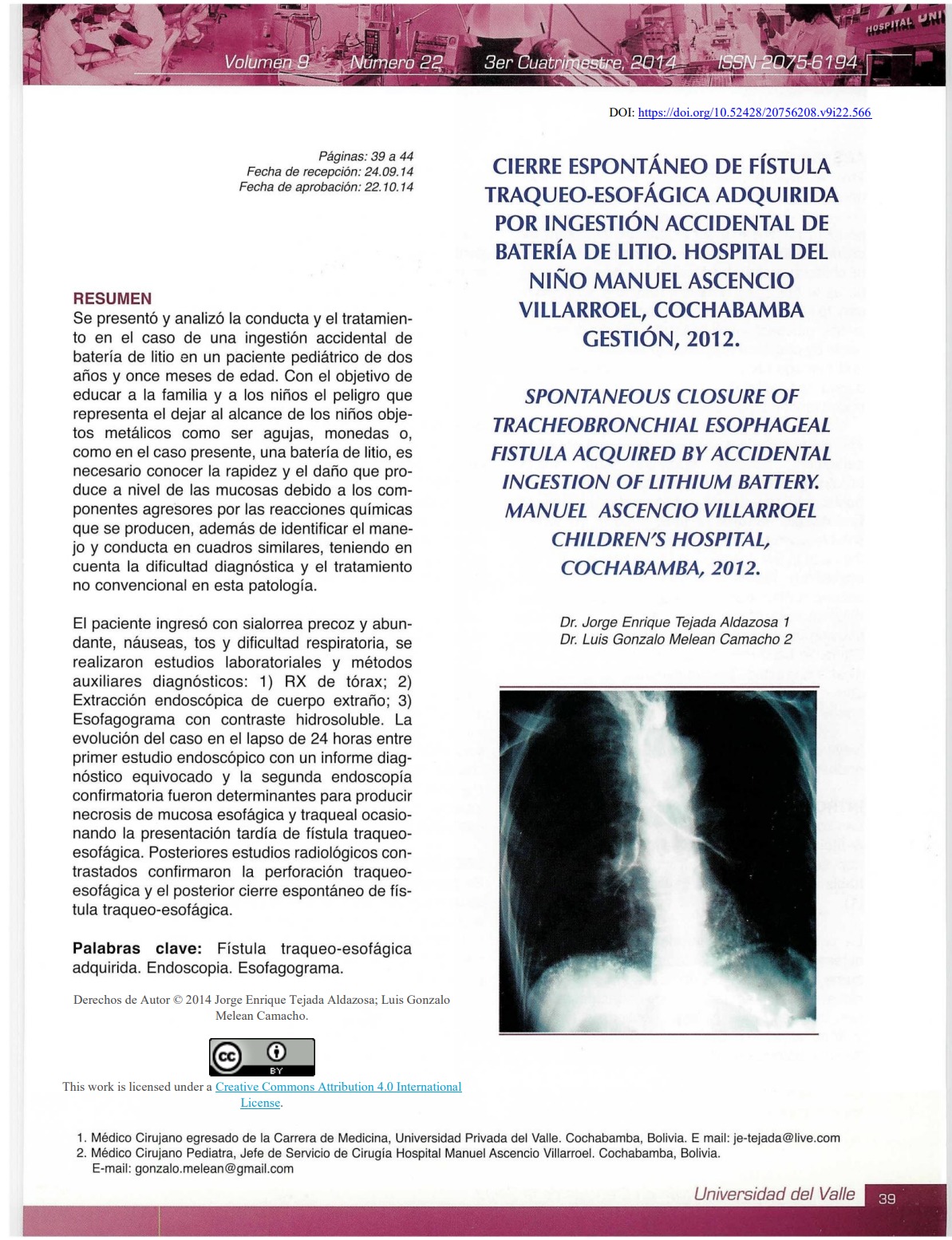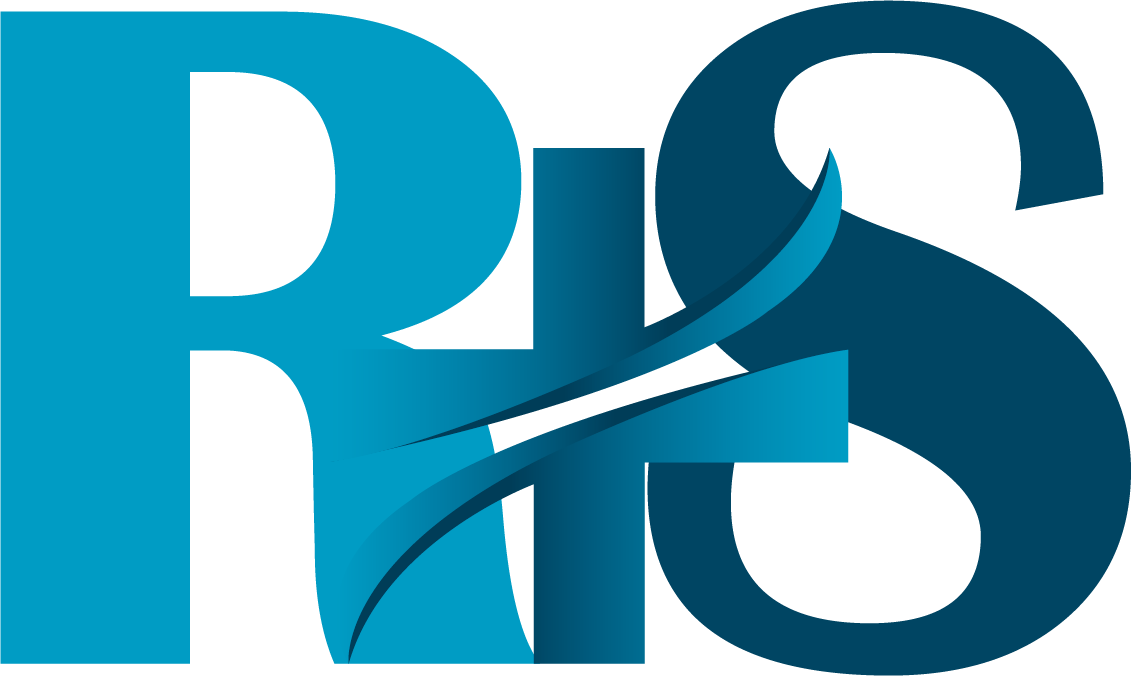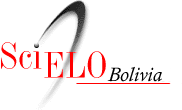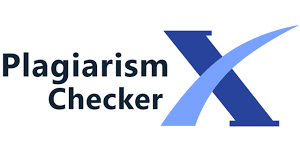Spontaneous Closure of Tracheobronchial Esophageal Fistula Acquired by Accidental Ingestion of Lithium Battery. Manuel Ascencio Villarroel Children's Hospital, Cochabamba, 2012
DOI:
https://doi.org/10.52428/20756208.v9i22.566Keywords:
Acquired Tracheo-Esophageal Fistula, Endoscopy, EsophagogramAbstract
The behavior and treatment of the case of accidental ingestion of lithium was presented and analyzed in a two years and eleven months old pediatric patient. In order to educate the family and children about the danger of letting near the reach of children metal objects such as needles, coins, or, as in this case, a lithium batteries, it is necessary to know the speed and the damage producing in the mucosal level because attackers components by chemical reactions, in addition, to identify and manage behavior in similar symptoms, considering the difficulty in diagnosing and treating unconventional pathologies. The patient was admitted with early and abundant salivation, nausea, coughing and difficult breathing, laboratory studies and auxiliary diagnostic methods were performed: 1) CXR; 2) Endoscopic removal of foreign body; 3) Watersoluble contrast esophagogram. The progress of the case in the space of 24 hours between the first endoscopy report a wrong diagnosis and the second confirmatory endoscopy was crucial to produce necrosis of esophageal and tracheal mucosa causing the late submission of tracheoesophageal fistula. Subsequent studies confirmed the radiological contrasted tracheoesophageal perforation and subsequent spontaneous closure of tracheoesophageal fistula.
Downloads
References
YARDENI, D., YARDENI, H., CORAN, A.G., ANO GOLLADAY, E.S. Severe esophageal damage due to button battery ingestion: can it be prevented?. Pediatr. Surg. lnt. 2004; 20: 496-501. https://doi.org/10.1007/s00383-004-1223-6
OSPINO J. Cuerpos extraños en el tracto aerodigestivo infantil. 2006 33: 36-47.
PELAEZ D. Aproximación a las urgencias quirúrgicas en Pediatría de Atención Primaria en servicio de cirugía pediátrica. BOL PEDIATR. 2006; 46: 351-57.
ARANA A, HAUSER B, HACHIMI-IDRISSI S, VANDENPLASY. Management of ingested foreign bodies in childhood and review of the literatura. Eur J Pediatr 2001; 160: 468-72. https://doi.org/10.1007/s004310100788
CONNERS, G. Excerpt From Pediatrics Foreign body lngestion. http://www.emedicine.com/emerg/byname/pediatrics-foreign-body-ingestion.htm
ALKAN, M., BUYUKYAVUZ, l., DOGRU, D., YALCIN, E., ANO KARNAK, l. Tracheoesophageal fistula dueto disc-battery ingestion. Eur. J. Pediatr. Surg. 2004; 14: 274-2786. https://doi.org/10.1055/s-2004-815875
ASHCRAFT, KEITH W. Cirugía pediátrica, capítulo 21, Esófago, p. 235-2339.
WALDO, N. Tratado de Pediatría, capítulo 328, Fístulas y Atresia Esofágica.
ANAND, T.S., KUMAR, S., WADHWA, V., ANO DHAWAN, R. Rare case of spontaneous closure of tracheo-esophageal fistula secondary to disc battery ingestion. lnt. J. Pediatr. Otorhinolaryngol. 2002; 63: 57-59. https://doi.org/10.1016/S0165-5876(01)00624-3
TAMAYO, L., TAPIA, R., YANIQUEZ, R. Lesiones cáusticas por ingesta de pilas alcalinas: reporte de dos casos. Rev. Cuadernos. 2008; 53 (1): 44-47.
BAQUERO, C., GUIJARRO, E. Cuerpo extraño en esófago. Causal de fístula traqueo esofágica. Salud Uninorte. 2002; 16: 53-68.

Downloads
Published
How to Cite
Issue
Section
License
Copyright (c) 2014 Jorge Enrique Tejada Aldazosa y Luis Gonzalo Melean Camacho

This work is licensed under a Creative Commons Attribution 4.0 International License.
Authors who publish with this journal agree to the following terms:
- Authors retain copyright and grant the journal right of first publication with the work simultaneously licensed under a Creative Commons Attribution License 4.0 that allows others to share the work with an acknowledgement of the work's authorship and initial publication in this journal.
- Authors are able to enter into separate, additional contractual arrangements for the non-exclusive distribution of the journal's published version of the work (e.g., post it to an institutional repository or publish it in a book), with an acknowledgement of its initial publication in this journal.
- Authors are permitted and encouraged to post their work online (e.g., in institutional repositories or on their website) prior to and during the submission process, as it can lead to productive exchanges, as well as earlier and greater citation of published work.






















